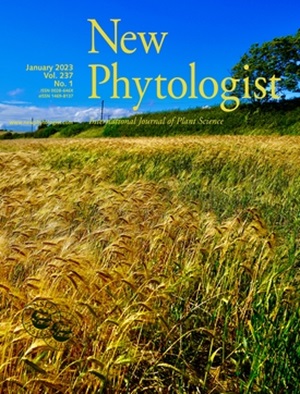CrRLK1L-RALF信号被忽视的方面
IF 8.1
1区 生物学
Q1 PLANT SCIENCES
引用次数: 0
摘要
植物的发育依赖于细胞与细胞壁的生物力学状态协调生长的能力。快速碱化因子(ralf)及其相关的Catharanthus roseus RLK1 - like (CrRLK1L)激酶受体构成了细胞壁感知与生长调控之间的动态信号系统。RALF-CrRLK1L信号触发亚分钟反应、离子通量、壁硬化和受体聚集,将其定位为实时生长调节的核心调节剂。ralf还通过压缩果胶在结构上起作用,在壁组成和信号之间引入反馈回路。crrlk1l与多个ralf的频繁共表达和异聚化表明,这是一种灵活的组合逻辑,而不是简单的单配体-单受体模型。这个Tansley Insight概述了一个概念框架,其中灵活的,模块化的受体配体网络可以作为动态细胞壁监测的基础。本文章由计算机程序翻译,如有差异,请以英文原文为准。
Overlooked aspects of CrRLK1L–RALF signaling
SummaryPlant development relies on the ability of cells to coordinate growth with the cell wall's biomechanical status. Rapid alkalinization factors (RALFs) and their Catharanthus roseus RLK1‐like (CrRLK1L) kinase receptors form a dynamic signaling system linking wall sensing to growth regulation. RALF–CrRLK1L signaling triggers subminute responses, ion fluxes, wall stiffening, and receptor clustering, positioning it as a core regulator of real‐time growth modulation. RALFs also act structurally by compacting pectins, introducing a feedback loop between wall composition and signaling. Frequent co‐expression and heteromerization of CrRLK1Ls with multiple RALFs argue for a flexible, combinatorial logic rather than simple one‐ligand‐one‐receptor models. This Tansley Insight outlines a conceptual framework in which flexible, modular receptor–ligand networks could underlie dynamic cell wall monitoring.
求助全文
通过发布文献求助,成功后即可免费获取论文全文。
去求助
来源期刊

New Phytologist
生物-植物科学
自引率
5.30%
发文量
728
期刊介绍:
New Phytologist is an international electronic journal published 24 times a year. It is owned by the New Phytologist Foundation, a non-profit-making charitable organization dedicated to promoting plant science. The journal publishes excellent, novel, rigorous, and timely research and scholarship in plant science and its applications. The articles cover topics in five sections: Physiology & Development, Environment, Interaction, Evolution, and Transformative Plant Biotechnology. These sections encompass intracellular processes, global environmental change, and encourage cross-disciplinary approaches. The journal recognizes the use of techniques from molecular and cell biology, functional genomics, modeling, and system-based approaches in plant science. Abstracting and Indexing Information for New Phytologist includes Academic Search, AgBiotech News & Information, Agroforestry Abstracts, Biochemistry & Biophysics Citation Index, Botanical Pesticides, CAB Abstracts®, Environment Index, Global Health, and Plant Breeding Abstracts, and others.
 求助内容:
求助内容: 应助结果提醒方式:
应助结果提醒方式:


